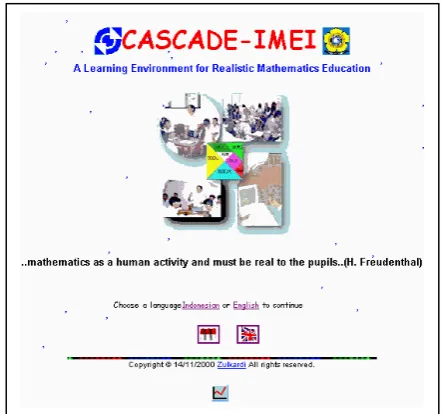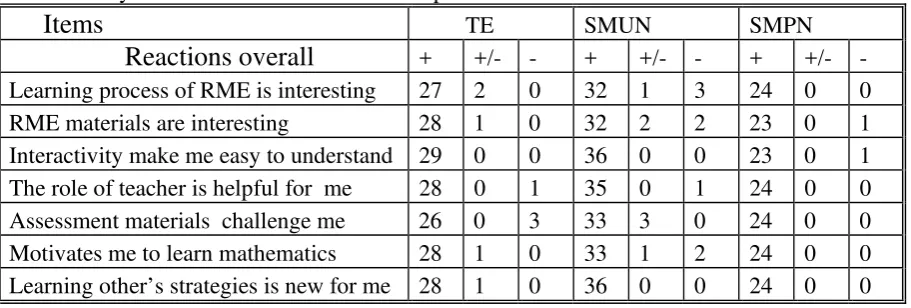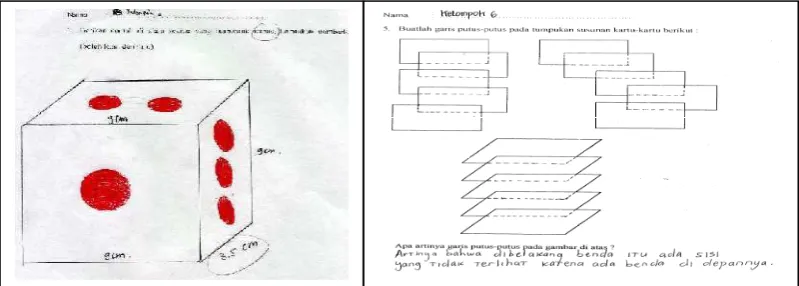CASCADE-IMEI: A LEARNING ENVIRONMENT OF REALISTIC MATHEMATICS FOR STUDENT TEACHERS IN INDONESIA
Zulkardi, University of Sriwijaya, Indonesia
Nienke Nieveen, University of Twente, the Netherlands
Abstract
This paper reports on the second phase of a four-year study which aims to develop a learning environment that supports prospective mathematics teachers learning realistic mathematics education (RME) in teacher education in Indonesia. The results suggest that by giving student teachers experiences in doing mathematics as learners during a course and providing additional information about RME in a web site can increase their performance in teaching realistic mathematics in the school classroom.
Introduction
This study is tied to the junior secondary mathematics education curriculum reform in Indonesia. In an attempt to combat the low achievement in mathematics of students in secondary school on national exams, the Indonesian government has attempted to identify probable reasons for this problem. Research cites various causes, including inaccurate learning materials, inadequate mechanistic teaching methods and poor forms of assessment (see also Zulkardi, 1999). One of the promising approaches toward the teaching and learning of mathematics that is thought to address the problems is realistic mathematics education (RME). RME is a theory of teaching mathematics that has been developed in the Netherlands since the early 70's (de Lange, 1987, 1996a; Freudenthal, 1991; Gravemeijer, 1994; Streefland, 1991). Contrary to the teaching approach that is common in Indonesia, RME uses contextual problems or applications as a source as well as a starting point for mathematics teaching.
The CASCADE-IMEI study (Computer Assisted Curriculum Analysis, Design and Evaluation for Innovation in Mathematics Education in Indonesia) focuses on the development and implementation of a learning environment for student teachers in Indonesia to learn to teach according the RME approach. The learning environment consists of a face-to-face course and a web site. In this paper we report on the results of the second phase of a development research project.
Theoretical Framework
The learning environment, including both the course and the web site, is designed based on the RME theory that is characterized in the five tenets of RME (also called progressive mathematization; de Lange, 1987, 1996a; Treffers, 1991; Gravemeijer, 1994). In short those are:
starting points from which the intended mathematics can come out).
(2) Use of models or bridging by vertical instruments (broad attention is paid to development models, schemas and symbolization rather than being offered the rule or formal mathematics right away).
(3) Use of students' contribution (large contribution to the course are coming from the student's own construction, which lead them from their own informal to the more standard formal methods).
(4)Interactivity (explicit negotiation, intervention, discussion, cooperation and evaluation among pupils and teachers are essential elements in a constructive learning process in which the student's informal strategies are used as a lever to attain the formal ones).
(5)Intertwining of learning strands (the holistic approach implies that learning strands can not be dealt with as separate entities; instead an intertwining of learning strands is exploited in problem solving).
De Lange (1993) pointed out several problems that were faced when Dutch experts introduced the RME approach in Dutch secondary education. The general problem was: How to educate teachers to learn using new materials and to teach with materials using the new approach? This appeared to be a complex endeavor due to several changes: (1) the mathematics materials differ from former ones; (2) the role of teachers change from teaching to 'unteaching' ; and (3) the assessment materials focus on middle-level and high-level order thinking instead of low level only. These changes need to be taken into account when considering implementation strategies for RME in Indonesia.
As a consequence of reform, alternative curricula, alternative teaching materials, and alternative forms of assessment are essential (Van den Heuvel-Panhuizen, 1996; Fullan, 1991). Selter (1997) pointed out that these are all mediated through the teacher, specifically through teacher's beliefs about how to organize and facilitate pupils' learning of mathematics. In this context, teacher education (pre-service as well as in-(pre-service) plays a vital role. One key strategy in this situation is to engage teachers or student teachers in their professional development using the following strategies (Loucks-Horsley, Hewson, Love & Stiles, 1998): (1) a short course (for building knowledge by teachers or student teachers); (2) curriculum development (by adapting the innovative materials into the school practice); and (3) using technology (in order to provide teachers or student teachers with rich information about the new approach).
Description of the learning environment
The Course and its materials
The RME course is developed in order to make student teachers understand what RME is and how to implement RME in the classroom. The main contents of this course include: (1) overview of the RME theory; (2) learning how to make or solve a number of contextual problems; (3) learning how to teach RME in the classroom; and (4) learning how to assess the students in the RME classroom.
The course materials are adapted from RME books that were developed by Freudenthal Institute experts as well as materials from the "Mathematics in Context" books (mathematics books for student grade 5-8 in USA) that were developed during the collaboration project between Freudenthal Institute and University of Wisconsin-Madison (Romberg, A. & de Lange J, 1998). Special adaptation to the Indonesian contexts occurred such as examples, curriculum level, and number of mathematics problems. Two topics were developed and used in the course, that is linear equation system and matrices. Due to space limitations, this paper only covers the first topic, linear equation system, which consists of 30 problems. Figures 1 shows an example of a realistic problem that is used in the assessment session of the course, 't-shirt and soda' problem (Van Reeuwijk, 1995; de Lange, 1996b).
Figure 1. "t-shirt and soda" problem
The web site
Figure 2 shows the front page of
the web site. Its address is at Figure 2. The front page of the web site
http://www.cascadeimei.com.
All course materials are also put on the web site, giving the students the opportunity to refer the course materials whenever they feel a need.
number of tools for web users such as: simulations and games on mathematics education which are made using a Java applets and Java script program; and (3) online talk elements that can be used to communicate to: the developer using e-mail; other online users using a chat utility; and all users using a mailing list.
Research Methodology Research phase and main questions
This study uses a development research approach (van den Akker, 1999; Nieveen, 1997). With this method, the learning environment is developed and evaluated in three main phases: preliminary study, prototyping phase and assessment phase. In the first phase, a preliminary prototype of the learning environment has been designed and evaluated with several experts in the Netherlands. After revising this preliminary prototype and adapting it to the Indonesian context it was implemented to the target group in teacher education in Bandung. The result of this formative evaluation of this prototype are discussed in the rest of this paper based on the following questions:
• What is the reaction of student teachers as well as pupils in two schools in Indonesia to RME as the content of learning environment?
• What is the practicality of the first prototype of the web site based on the appraisal of student teachers?
• What is the effect of the learning environment to the performance of mathematics student teachers in Indonesia?
Participant
The participants of the formative evaluation of the course were 29 in-service student teachers at the Department of Mathematics Education, Indonesian Educational University in Bandung, Indonesia. All participants are mathematics teachers who work on their bachelor degree for two days a week and being a teacher in the secondary school four days a week. They don't have prior knowledge on RME. At the end of the course two participants, Mr. D. and Mr. S., were selected based on their knowledge and skill as well as their motivation during the course to participate in a working group in implementing the RME materials in their schools. Mr. D, a teacher at the state junior high school (SMPN 2 Bandung), implemented the RME materials in his class with 24 pupils (age 12-15) while Mr. S., a teacher at the state senior high school (SMUN 1 Cimahi Bandung), implemented the RME materials in his class with 37 pupils (age 16-19).
The formative evaluation of The Web site was carried out with the same two student teachers.
Instruments
instruments that were used in evaluating the Web site are an observation form and a logbook for collecting data from the student teachers.
Procedure
The course was implemented in the teacher education. The activities were conducted within a time frame of three blocks of two-hours. After the participants filled out the entry questionnaire the course started by giving the participants information about the basic principles of RME and its characteristics. Then some examples of realistic mathematics problems were given and discussed in groups so they got the idea of each characteristic of RME. Next, the student teachers were given a number of RME problems in two topics (linear equation system and matrices). After they solved the problems, they were guided in discussing the various strategies and in several cases they were invited to present their answers in front of the class. Finally, at the end of the course they were tested to see their performance in solving the problems. In addition, they filled out the final questionnaire. Two course participants were followed when they implemented the RME lessons in their classes. They developed the lesson materials in collaboration with the researcher. The researcher observed their lessons.
The web site was evaluated using a cooperative evaluation, during which the two student teachers performed as users and were asked to work aloud.
Results and Discussion
We present the results and discuss them based on the questions that were stated in the introduction.
(1) What is the reaction of student teachers as well as pupils in schools in Indonesia to RME as the content of learning environment?
The reactions of student teachers and pupils in the school that were gathered by a similar questionnaire are summarized in the table 1.
Table 1. The results of final questionnaire of 29 student teachers in teacher education (TE), 36 senior high school students (SMUN) and 24 junior high school students (SMPN) after they followed the RME instruction process.
Items TE SMUN SMPN
Reactions overall + +/- - + +/- - + +/- - Learning process of RME is interesting 27 2 0 32 1 3 24 0 0 RME materials are interesting 28 1 0 32 2 2 23 0 1 Interactivity make me easy to understand 29 0 0 36 0 0 23 0 1 The role of teacher is helpful for me 28 0 1 35 0 1 24 0 0 Assessment materials challenge me 26 0 3 33 3 0 24 0 0 Motivates me to learn mathematics 28 1 0 33 1 2 24 0 0 Learning other’s strategies is new for me 28 1 0 36 0 0 24 0 0
The result in table 1 illustrates that the participants are very interested in the RME teaching approach both in the teacher education and schools. These positive reactions from participants are a necessary prerequisite to higher level evaluation results. The items refer to the characteristics of RME. For instance, from the second item 'RME materials are interesting', it can be perceived that the materials that were used are real to their situation (the first characteristic of RME). Finally, they found something new in learning mathematics such as the interactivity and a chance to learn other's strategies during the discussion.
(2) What is the practicality of the first prototype of the Web site based on the appraisal of student teachers?
The feedback from the two student teachers Mr.D. and Mr.S. mainly focused on how they got interested in using the web site for the first time. For instance, they were very joyful with simulations and games. In addition, they suggested to put more realistic lessons on the Web site.
(3) What is the effect of the learning environment to the performance of student teachers in teacher education in Indonesia?
In order to answer this question three kind of results are used. First, student teachers solutions on a test at the end of the course. An example of a test item is the "t-shirt and soda" problem (see figure 1). Before starting the test, student teachers were asked not to use the 'old strategy' of linear algebra. All of them can solve the problem but some of them could not find a new strategy. Figure 3 shows two types of solutions: one is formal (Syukur's) and one is 'informal' (Eulis'). The solution of Eulis is similar to the 'counting on' strategy (see Van Reeuwijk, 1995; de Lange, 1996b). She starts by taking away a t-shirt and two cups from each picture which leaves a shirt is 14 more expensive than a cup of soda. Then, she substitutes the t-shirt in the second picture with a cup and subtracts the price 30 with 14. Finally, from the 'third picture' where four cups equal to 16, she gets the price of a cup is 4.
Second, the knowledge of student teachers in developing lessons based on the RME tenets. Here, two lessons based on the RME tenets that were developed by Mr. D. (the cube) and Mr. S. (the general graph) were evaluated. Figure 4 illustrates two examples of the cube problems that were tested in his class. On the left, pupils were asked to draw a cube they are familiar with. One can see from the figure that the pupil knew that a dice is a cube. On the right, pupils were asked to complete the graph by drawing the 'dash-line' and to explain what the line means. This is an example of true solution of the pupil.
Figure 4. Two examples of the cube problems
Finally, the teaching skills of Mr.D. and Mr. S. were observed by the researcher. An overall impression was that they were able to teach using 'realistic materials'. They used their knowledge from teacher education such as how to start the lesson, make groups of students, guide group and class discussions and close the lesson. However, they also had some problems such as how to motivate the students to get involved in the discussion and how to conclude the lesson.
Conclusion
Based on the results in the previous section it can be concluded that:
• The RME course was evaluated as an interesting approach both by student teachers in teacher education as well as by pupils in secondary schools.
• The web site was judged to be practical by student teachers as a part of learning environment. However, this positive feedback also came with a number of remarks or revision suggestions in order to improve the next prototype of the web site.
Acknowledgment. This study is funded by World Bank Indonesian Secondary Teacher
Development (PGSM) project IBRD Loan No. 3979-IND. We wish to thank you to the project, students, Indonesian' s co-supervisor and supervisors both from the University of Twente and the Freudenthal Institute for their support.
References
Akker, J., van den (1999). Principle and Methods of Development Research. In: J. van den Akker, R. Branch, K. Gustafson, N. Nieveen & Tj. Plomp (Eds), Design methodology and developmental research. Dordrecht : Kluwer.
De Lange, J. (1987). Mathematics, insight and meaning. Utrecht: OW &OC.
De Lange, J. (1993). Innovation in mathematics education. In de Lange, Keitel, Huntley and Niss (eds). Innovation in maths education by modelling and applications, (pp. 3-17). Chichester: Ellis Horwood.
De Lange, J. (1996a). Using and applying mathematics in education. In: A.J. Bishop, K. Clements, Ch. Keitel, J. Kilpatrick and C. Laborde (eds). International handbook of mathematics education, Part one (pp.49-97). Dordrecht: Kluwer Academic Publishers. De Lange, J. (1996b). Real problems with real world mathematics. In Proceedings of the 8 th International Congress on Mathematical Education (pp.83-109). Sevilla, 14-21 July. Freudenthal, H. (1991). Revisiting mathematics education. China Lectures. Dordrecht: Kluwer Academic Publishers.
Fullan, M. (1991). The new meaning of education change. New York: Teacher College Press. Gravemeijer, K.P.E. (1994). Developing realistic mathematics education. Utrecht: CD-ß Press / Freudenthal Institute.
Loucks-Horlsey, S., Hewson, P.W., Love. N. and Stiles, K.E.(1998). Designing professional development for teachersof science and mathematics. Thousand Oaks: Corwin Press.
Nieveen, N.M.(1997). Computer support for curriculum developers: A study on the potential of computer support in the domain of formative curriculum evaluation. Doctoral Dissertation. Enschede: University of Twente
Romberg, A. & de Lange J. (1998). Mathematics in context: Get the most out of it. Grade 8 Algebra Strand. Chicago: Britannica Mathematics system.
Streefland, L. (1991). Fractions in realistic mathematics education. A paradigm of developmental research. Dordrecht: Kluwer Academic Publishers.
Selter, C. (1997). Instructional design for teacher education. In M. Beishuizen, K.P.E. Gravemeijer, E.C.D.M.van Lieshour (Eds.). The role of contexts and models in the development of mathematics strategies and procedure. (pp. 55-77). Utrecht: CD-B Press / Freudenthal Institute.
Treffers, A. (1991). Realistic mathematics education in The Netherlands 1980-1990. In L. Streefland (Ed.), Realistic mathematics education in primary school. Utrecht: CD-B Press / Freudenthal Institute.
Van den Heuvel-Panhuizen, M. (1996). Assessment and realistic mathematics education. Utrecht: CD-B Press / Freudenthal Institute.
Van Reeuwijk, M. (1995). Students' knowledge of Algebra. In Proceedings of PME 19, vol.1 (pp. 135-150): Recife, Brazil


